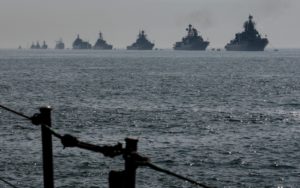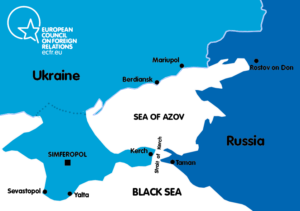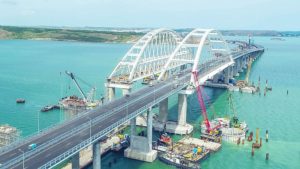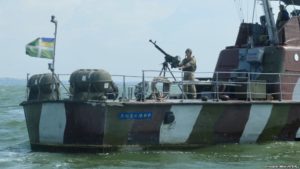
Russia has for some time being using its military to apply increasingly tight controls on Ukraine’s international trade routes passing through the Sea of Azov. It has now reached the point where openly aggressive moves against Ukrainian ships are being contested by the under-resourced Ukrainian coastguard and navy. Many regard this as a precursor to Mr Putin’s aim to destroy Ukraine’s economy and force its self-governing southeastern provinces to join Russian controlled Eastern Ukraine and Crimea.

The Sea of Azov is a semi-landlocked area of water which Ukraine and Russia agreed in 2003 to use jointly and freely. However, since the annexation of the Crimea, and as the map shows, access to southern Ukrainian ports such as Mariupol is via the Strait of Kerch which is bounded on both sides by Russian Naval controlled territory. In addition, the Russians have built a bridge across the strait which, with 35m clearance under the central span, is too low for large ships to use.
The significance of this last point is that Mariupol is the main steel and ore-exporting port of the Ukraine and Russia knew exactly what it was doing when it designed the bridge. In addition, the Russian navy is now inspecting ships passing through the straits, causing up to week-long delays. This is intended to deter international shipping companies from doing business with Ukrainian ports and effectively imposes a blockade on the region.

The history of planned bridges across the straits is a long one, going back to a British proposal in the 1870s. In WW2 the Germans attempted to build one to shorten the supply routes to their forces attempting to take the oil fields in the southeastern corner of the Soviet Union. However, they were frustrated by Soviet advances in 1943 and blew up the structures already completed by the time they were forced to retreat. After the War, the Soviets themselves considered a bridge, and after Ukraine gained its independence from Russia, the two countries worked on a joint project for a while, though nothing came of it.
From a military perspective, the recent Russian Naval moves are being viewed with concern. A Russian Naval presence close to the Ukrainian shore might put at risk the relatively immobile Ukrainian forces dug-in and facing the Russian-backed break-away provinces in what was Eastern Ukraine. There are already talks about having to move those forces back to prevent them from being cut-off in the event of another Russian military move which might include an invasion of sorts along Ukraine’s south-east coastline. In addition, Russian ship-based missiles can now reach deep into Ukraine itself, a threat that has not gone unnoticed.
Some go further and say that if the current Russian plan is successful they might try the same tactics along the coast to the west of the Crimean peninsula, extending a blockade to Ukraine’s only remaining seaports.

It has to be remembered that Ukraine is not entirely powerless. It does have some limited forces in the area and is said to be increasing its presence to be ready for any Russian escalation. However, its main card is the fact that it controls much of the Crimea’s water supplies and has been blockading the Crimea since the Russians seized it; hence the Russian need for a bridge.
Western and international response to date has been almost non-existent. However, the increasing effects on western shipping have forced some to reconsider the matter and there is now talk of a UN Maritime Peacekeeping Operation that would ensure free passage of ships (small enough to go under the bridge of course). It is also feared that Russia will simply keep piling on the pressure as long as the rest of the world ignores this issue and that they might indeed be sufficiently emboldened to re-start ground operations to secure the industrial heartland of Eastern Ukraine – a long-term goal of Mr Putin’s.

Comments on Russian naval stranglehold on SE Ukraine tightens